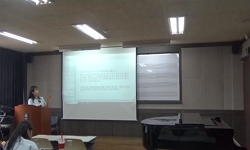This paper explores the fugal narrative and its effects in the `Sirens` chapter of Ulysses. It examines how Joyce`s adaptation of the musical devices for his linguistic devices has an effects on the structure and the theme of the `Sirens`. In tis narr...
http://chineseinput.net/에서 pinyin(병음)방식으로 중국어를 변환할 수 있습니다.
변환된 중국어를 복사하여 사용하시면 됩니다.
- 中文 을 입력하시려면 zhongwen을 입력하시고 space를누르시면됩니다.
- 北京 을 입력하시려면 beijing을 입력하시고 space를 누르시면 됩니다.
https://www.riss.kr/link?id=A40099247
- 저자
- 발행기관
- 학술지명
- 권호사항
-
발행연도
2003
-
작성언어
-
-
주제어
fugal narrative ; musical devices ; linguistic devices ; rhyme ; rephrasing ; deconstruction ; 푸가적 서술 기법 ; 음악적 서술 방안 ; 리듬 ; 반복 어구 ; 해체성
-
KDC
800
-
등재정보
KCI등재
-
자료형태
학술저널
- 발행기관 URL
-
수록면
75-96(22쪽)
-
KCI 피인용횟수
0
- 제공처
-
0
상세조회 -
0
다운로드
부가정보
다국어 초록 (Multilingual Abstract)
This paper explores the fugal narrative and its effects in the `Sirens` chapter of Ulysses. It examines how Joyce`s adaptation of the musical devices for his linguistic devices has an effects on the structure and the theme of the `Sirens`. In tis narrative and structure, the `Sirens` follows a musical development rather than a logical development. The fugal structure of Subject, Answer, Counter-Subject, and Episodes becomes the fundamental structure of the chapter, and the themes are suggested and implied in the fugal manner. Since the music is the art of this chapter, the sound is the primary concern in its use of language through the devices such as alliteration, assonance, onomatopoeia, rhyme, etc. Joyce`s verbal virtuostity reflects the musical allusions of stretto, cadence, coda, divertimenti, trillando, staccato and diminuendo. The sentence rhythms in the repetitive rephrasing are the main musical device. Because of the experimentation with words the grammar is often disturbed and the words are distorted in a musical form. This paper also explores how the musical devices are matched with deconstructive narrative and how they work for the theme of allurement and of the `Sirens`, that of overcoming its dangers.
동일학술지(권/호) 다른 논문
-
- 한국제임스조이스학회
- 이종일 ( Lee Jong Il )
- 2003
- KCI등재
-
가블러의 『율리시즈』개정판(1986)과 엘만의 「서문」
- 한국제임스조이스학회
- 진선주 ( Jin Seon Ju )
- 2003
- KCI등재
-
- 한국제임스조이스학회
- 김상효 ( Kim Sang Hyo )
- 2003
- KCI등재
-
Body as a Signifier: Eveline`s Nausea
- 한국제임스조이스학회
- 윤희환 ( Yun Hui Hwan )
- 2003
- KCI등재
분석정보
인용정보 인용지수 설명보기
학술지 이력
| 연월일 | 이력구분 | 이력상세 | 등재구분 |
|---|---|---|---|
| 2026 | 평가예정 | 재인증평가 신청대상 (재인증) | |
| 2020-01-01 | 평가 | 등재학술지 유지 (재인증) |  |
| 2017-01-01 | 평가 | 등재학술지 유지 (계속평가) |  |
| 2013-01-01 | 평가 | 등재학술지 유지 (등재유지) |  |
| 2010-01-01 | 평가 | 등재학술지 유지 (등재유지) |  |
| 2008-01-01 | 평가 | 등재학술지 유지 (등재유지) |  |
| 2005-01-18 | 학술지등록 | 한글명 : 제임스조이스저널외국어명 : James Joyce Journal |  |
| 2005-01-01 | 평가 | 등재학술지 선정 (등재후보2차) |  |
| 2004-01-01 | 평가 | 등재후보 1차 PASS (등재후보1차) |  |
| 2003-01-01 | 평가 | 등재후보학술지 선정 (신규평가) |  |
학술지 인용정보
| 기준연도 | WOS-KCI 통합IF(2년) | KCIF(2년) | KCIF(3년) |
|---|---|---|---|
| 2016 | 0.06 | 0.06 | 0.08 |
| KCIF(4년) | KCIF(5년) | 중심성지수(3년) | 즉시성지수 |
| 0.09 | 0.09 | 0.386 | 0 |




 KISS
KISS





